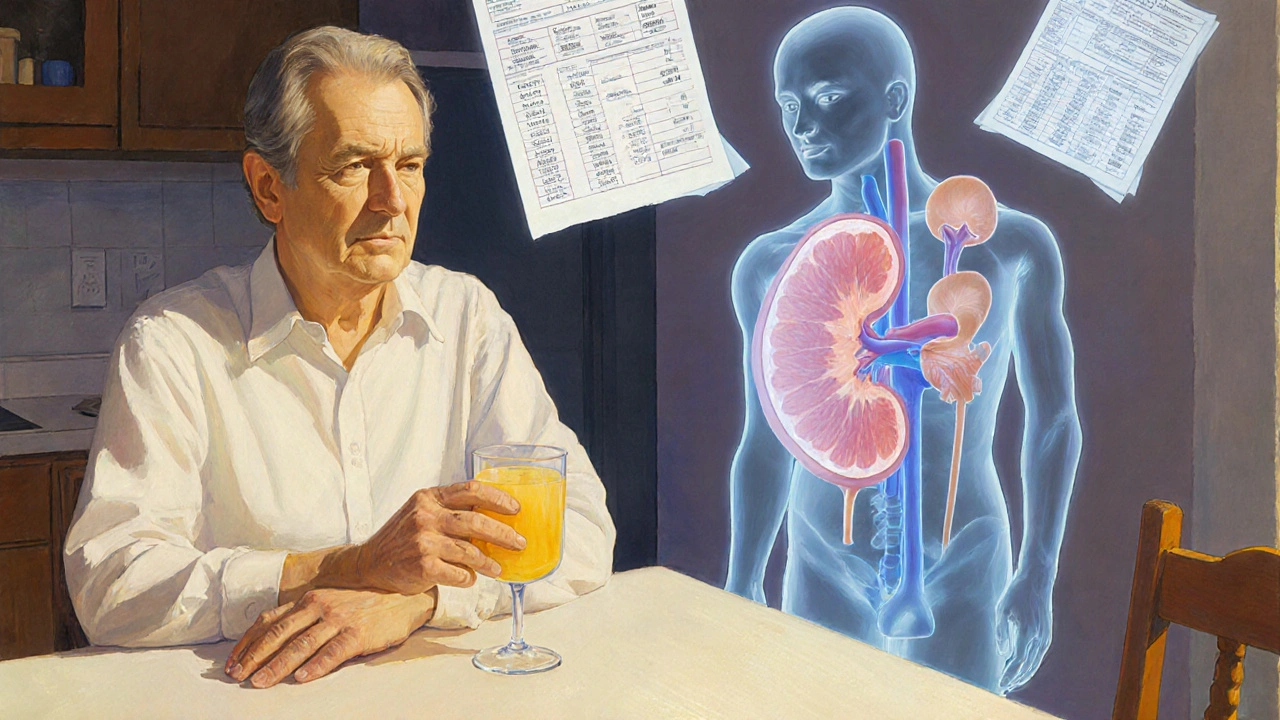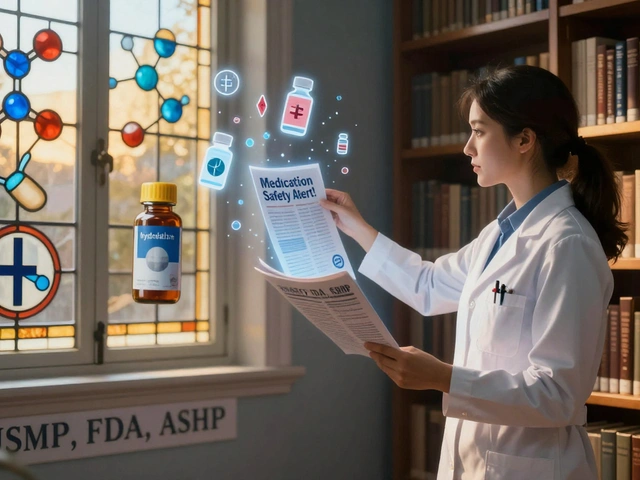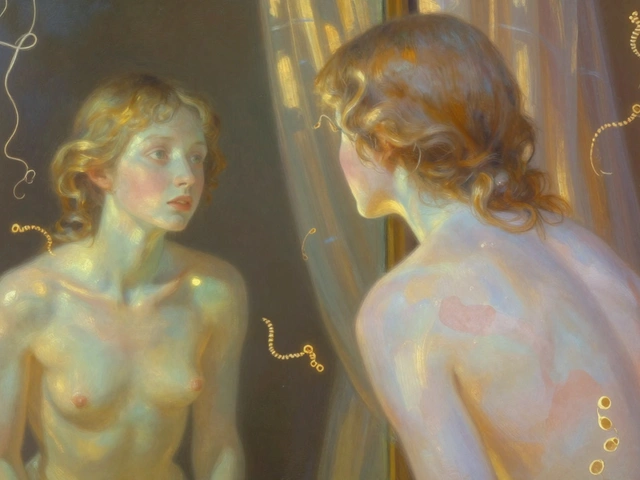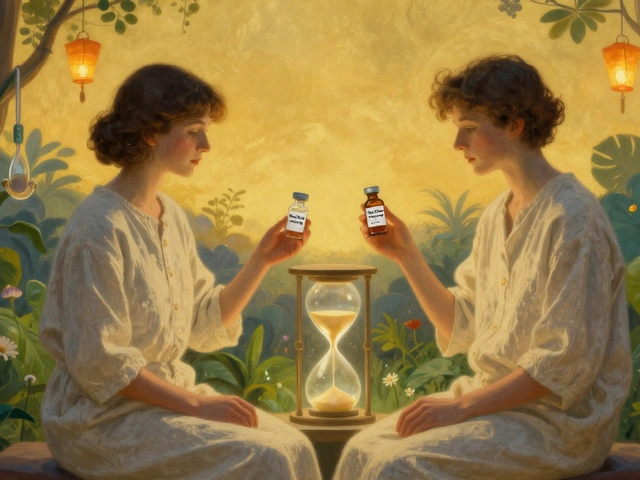Cyclosporine Kidney Monitoring Tracker
C2 Monitoring Time Calculator
Calculate the correct time for your cyclosporine blood draw based on when you take your dose.
ℹ️ C2 monitoring requires blood drawn exactly 2 hours after taking cyclosporine. Even a 15-minute difference can affect results.
Kidney Function Assessment
Enter your current kidney function markers to assess your risk of cyclosporine nephrotoxicity.
Current Risk Assessment
When you take cyclosporine after a transplant, your body needs just the right amount-too little and your immune system attacks the new organ; too much and your kidneys start to fail. This isn’t a guesswork situation. It’s a tightrope walk measured in nanograms per milliliter. For over 40 years, cyclosporine has kept transplant patients alive, but its shadow-nephrotoxicity-has claimed nearly half of long-term kidney grafts when not managed properly. The good news? You can prevent most of it. The key is knowing exactly how to monitor both the drug in your blood and the health of your kidneys, down to the last detail.
Why Cyclosporine Is So Hard to Get Right
Cyclosporine doesn’t play by normal rules. Its therapeutic window-the gap between working dose and toxic dose-is razor-thin. One day your level might be safe at 180 ng/mL; the next, after eating grapefruit or taking an antibiotic, it spikes to 280 ng/mL and starts damaging your kidneys. This isn’t rare. About 30% to 50% of kidney transplant patients who don’t get careful monitoring end up losing their grafts because of kidney damage from cyclosporine. That’s not just a side effect-it’s the leading cause of long-term transplant failure.
What makes it worse? Your body handles cyclosporine differently than your neighbor’s. One person might need 200 mg daily to stay in range; another needs 350 mg. Why? Genetics. Some people are fast metabolizers because of their CYP3A5 gene. If you’re one of them, your body clears the drug too quickly. Your doctor might think you’re underdosed when you’re actually just a fast burner. That’s why blanket dosing doesn’t work anymore.
How Blood Levels Are Measured-And Why It Matters
Not all blood tests for cyclosporine are created equal. Ten years ago, most labs used immunoassays-cheap, fast, and widely available. But here’s the catch: they can’t tell the difference between cyclosporine and its metabolites. Those metabolites aren’t active drugs, but immunoassays mistake them for the real thing. That means your reported level could be 20% higher than what’s actually in your blood. You might get your dose lowered unnecessarily, putting you at risk for rejection.
Today, nearly 92% of U.S. transplant centers use LC-MS/MS-liquid chromatography-tandem mass spectrometry. It’s accurate to 99.2%. It doesn’t confuse metabolites. It can detect levels as low as 5 ng/mL. That precision means fewer mistakes, fewer hospital visits, and better long-term outcomes. If your lab still uses immunoassays, ask why. You deserve better.
When to Draw Blood-C0 vs. C2 Monitoring
For decades, doctors only checked your cyclosporine level right before your next dose-the “trough” or C0 level. But here’s what they found: C0 doesn’t tell you enough. It’s like checking your gas tank only when you’re pulling into the driveway. You might still be running on fumes.
Now, the gold standard is C2 monitoring-drawing blood exactly two hours after you take your dose. Why? Because C2 levels correlate much better with the total drug exposure over 24 hours (the area under the curve). Studies show C2 monitoring cuts acute rejection by 18% and reduces nephrotoxicity by over 22%. It’s not just theory-it’s practice in top transplant centers.
But timing matters. If you take your pill at 8 a.m., the blood draw must happen at 10 a.m., not 10:15. Even 15 minutes off can throw off the result. And you can’t just skip meals or drink coffee before the test-those change absorption. Your pharmacy or transplant team should give you a written schedule: what to eat, when to take the pill, when to come in.

What Your Kidneys Are Telling You
Monitoring the drug isn’t enough. You have to monitor your kidneys too. Here’s what your doctor should check every time:
- Serum creatinine: Keep it under 1.5 mg/dL. A rise of 0.3 mg/dL over a week is a red flag.
- BUN-to-creatinine ratio: Should stay below 20:1. A higher ratio suggests reduced blood flow to the kidneys-a sign of cyclosporine-induced vasoconstriction.
- Magnesium levels: Cyclosporine makes you lose magnesium. Normal is 1.7-2.2 mg/dL. Low magnesium means your kidneys are stressed and you’re at higher risk for arrhythmias.
- Blood pressure: Target is under 130/80 mmHg. Cyclosporine causes high blood pressure in up to 70% of users. Uncontrolled pressure accelerates kidney damage.
Don’t wait for symptoms. Nephrotoxicity doesn’t cause pain or swelling early on. By the time you feel tired or notice less urine, the damage is already there. Monthly labs aren’t optional-they’re your lifeline.
Drugs That Can Sabotage Your Levels
Even if you’re perfect with your dosing, something else you take could be messing with your cyclosporine levels. Common culprits:
- Ketoconazole (antifungal): Increases cyclosporine by 30-50%. Avoid it unless your doctor adjusts your dose.
- Rifampin (TB drug): Cuts cyclosporine levels by 40-60%. You might reject your transplant without realizing why.
- Grapefruit juice: Blocks the enzyme that breaks down cyclosporine. One glass can double your blood level.
- St. John’s Wort: Speeds up clearance. You could end up with rejection in days.
Always tell every new doctor you see-dentist, pharmacist, ER staff-that you’re on cyclosporine. Even over-the-counter supplements can interfere. Keep a printed list of all your meds and bring it to every appointment.
Reversibility-It’s Not Always Permanent
Here’s something most patients don’t know: cyclosporine kidney damage can often be reversed-if caught early. Studies from the 1980s showed that when doctors lowered cyclosporine doses quickly after spotting rising creatinine, kidney function improved in 70% of cases within three months. The damage isn’t always scarring. Sometimes it’s just the blood vessels tightening up. Let it go too long, and you get permanent scarring-arteriolar hyalinosis, tubular atrophy. That’s irreversible.
That’s why early detection is everything. If your creatinine jumps 20% above baseline, don’t wait. Call your transplant team. They might reduce your dose, switch you to a different drug, or add a blood pressure medication to protect your kidneys. Delaying by even a few weeks can change your long-term prognosis.
What’s Next? The Future of Monitoring
Technology is catching up. Right now, Phase 3 trials are testing point-of-care devices that can measure cyclosporine in whole blood in under 15 minutes-no lab needed. Imagine getting your level checked during your clinic visit, right after your blood draw. No waiting days for results. No guesswork.
Artificial intelligence is also stepping in. New algorithms are being trained on 17 variables-your weight, age, genetics, diet, other meds, even your sleep patterns-to predict your ideal cyclosporine dose with 89.7% accuracy. These tools could eventually cut blood draws from weekly to monthly for stable patients.
But none of this replaces vigilance. Even the smartest AI can’t replace your awareness. You’re the one who notices if your urine looks darker, if your ankles are swelling, if you’re more tired than usual. You’re the first line of defense.
What You Can Do Today
You don’t need to be a medical expert to protect your kidneys. Here’s your action list:
- Know your target cyclosporine levels: 100-150 ng/mL after one year (confirm with your doctor).
- Ask your lab if they use LC-MS/MS for testing. If not, ask why.
- Stick to C2 monitoring if your center offers it. Don’t settle for C0 alone.
- Track your creatinine, blood pressure, and magnesium levels in a notebook or app.
- Never start a new medication, supplement, or herbal product without checking with your transplant team.
- Keep a list of all your drugs and bring it to every appointment.
- If your creatinine rises, act fast-don’t wait for your next scheduled visit.
Cyclosporine saved your life. But it’s not a cure. It’s a tool. And like any tool, it works best when you understand how to use it-and when to ask for help.
Can cyclosporine damage my kidneys even if my levels are in range?
Yes. Even within the "target" range, cyclosporine can cause kidney damage over time, especially if you’ve been on it for years. The drug narrows blood vessels in the kidneys, reducing blood flow. That’s why regular monitoring of creatinine, blood pressure, and magnesium is just as important as checking your drug level. Some patients need lower targets if they show early signs of kidney stress.
How often should I get my cyclosporine levels checked?
In the first month after transplant, you’ll likely be tested twice a week. From months 2 to 6, weekly checks are standard. After one year, if your levels and kidney function are stable, you may drop to every two to four weeks. But if you change meds, get sick, or your creatinine rises, your doctor will increase testing frequency. Never skip a test just because you feel fine.
Is there a safer alternative to cyclosporine?
Tacrolimus is the most common alternative-it’s more potent and has a slightly better kidney safety profile, though it still carries nephrotoxic risk. Sirolimus and belatacept are other options, often used later to reduce cyclosporine exposure. But switching isn’t automatic. Your doctor will weigh rejection risk, side effects, and your medical history. Many patients stay on cyclosporine long-term because it works well for them.
Can I drink alcohol while taking cyclosporine?
Moderate alcohol (one drink per day) is usually okay if your liver and kidneys are healthy. But heavy drinking increases your risk of liver damage and can raise blood pressure-both of which worsen cyclosporine toxicity. Avoid binge drinking. Always check with your transplant team before drinking, especially if you’re on other medications.
Why do I need EDTA tubes for my blood draw?
Cyclosporine binds to blood cells, not serum. If your blood is drawn into a serum separator tube (red or gold top), the drug can leak out or bind differently, giving falsely low results. EDTA tubes (purple top) preserve the whole blood sample, ensuring accurate measurements. Always confirm your lab uses EDTA tubes for cyclosporine testing.
What should I do if I miss a dose of cyclosporine?
If you miss a dose and remember within 4 hours, take it right away. If it’s been longer, skip it and take your next dose at the regular time. Never double up. Missing doses increases rejection risk, but doubling up can spike your levels dangerously. Call your transplant center if you miss more than one dose-they may want to check your blood level sooner.
If you’ve been on cyclosporine for years, you’ve likely learned to live with its demands. But you don’t have to accept kidney damage as inevitable. With precise monitoring, smart choices, and the right team, you can protect your transplant-and your future-for decades to come.






Comments
Vinicha Yustisie Rani
2 November 2025Cyclosporine is one of those drugs that makes you realize medicine isn't just about science-it's about patience, discipline, and listening to your own body. I've been on it for eight years after my kidney transplant, and what surprised me most wasn't the side effects, but how much control I gained by tracking my numbers like a diary. Creatinine, BP, magnesium-these aren't just lab values. They're conversations with your future self.
Carlo Sprouse
2 November 2025It is imperative to note that the utilization of LC-MS/MS methodology for cyclosporine quantification represents not merely an advancement, but a paradigmatic shift in therapeutic drug monitoring. The persistence of immunoassay-based protocols in certain institutions constitutes a clinically indefensible lapse in standards of care. Furthermore, the failure to implement C2 monitoring is tantamount to therapeutic negligence in the context of modern transplant medicine.
Cameron Daffin
3 November 2025I love how this post breaks it all down without making you feel like you need a PhD to understand it 😊 Honestly, I was terrified when I first started on cyclosporine-like, what if I mess up and lose my new kidney? But learning about C2 timing and the EDTA tubes? That made me feel like I actually had power in this process. I started keeping a little notebook with my numbers and even set phone reminders for blood draws. It’s not perfect, but I sleep better now. Also, grapefruit juice is officially banned in my house. One sip and I’m sweating bullets.
Sharron Heath
3 November 2025While the emphasis on precise laboratory methodology and pharmacokinetic monitoring is commendable, one must also acknowledge the systemic barriers that prevent many patients from accessing these standards. Cost, geographic isolation, and insurance limitations often render LC-MS/MS and C2 monitoring inaccessible. A comprehensive approach must include advocacy for equitable care alongside clinical precision.
Steve Dressler
3 November 2025Let’s be real-this drug is a beast. I’ve had my transplant for six years, and I’ve learned to respect cyclosporine like a grumpy old roommate who never cleans up after themselves. But here’s the thing: the moment I stopped treating it like a magic pill and started treating it like a living, breathing variable-affected by my sleep, my stress, my damn coffee-I stopped having scary spikes. And yeah, I use EDTA tubes. Always. I even printed out a sign for my fridge: ‘NO GRAPEFRUIT. EVER.’ My transplant nurse cried when she saw it.
Carl Lyday
3 November 2025Just wanted to add something practical: if you’re on cyclosporine and you’ve got low magnesium, don’t just take a random supplement. Talk to your pharmacist. Some OTC magnesiums have fillers that can interfere. I switched to magnesium glycinate after my nurse pointed out my levels kept dropping even with supplements-and it made a difference. Also, if you’re doing C2 monitoring, mark your calendar like it’s your birthday. Set three alarms. One hour before, one at the time, and one 15 minutes after. Trust me, you’ll thank yourself later.
Tom Hansen
3 November 2025why do we even use this crap anymore like i get its old and works but come on its basically poison with a side of stress and half the docs dont even know what c2 means lol
Donna Hinkson
4 November 2025I appreciate the thoroughness of this post. It’s rare to see such clarity on a topic that’s so often buried in jargon. I’ve been on cyclosporine for over a decade, and I’ve learned to manage it quietly-no fanfare, no drama. Just steady checks, careful notes, and a deep respect for the balance it requires. Thank you for reminding us that vigilance is not fear-it’s care.
Rachel M. Repass
5 November 2025Let’s talk about the elephant in the room: the CYP3A5 polymorphism. If you’re a *expressor* (CYP3A5*1/*1 or *1/*3), you’re essentially a human metronome for drug clearance-fast, efficient, and terrifyingly unpredictable. Most clinicians still treat you like a standard patient, but your dose needs to be calibrated with pharmacogenomics, not guesswork. I’ve seen patients on 500mg/day still have subtherapeutic levels because their doctor didn’t order the SNP test. Don’t be that person. Ask for your genotype. It’s not expensive. It’s life-saving. And if your center won’t do it? Advocate. Push. Because this isn’t just about science-it’s about justice in dosing.
Arthur Coles
7 November 2025Okay but who really controls the labs? I’ve been told my levels are fine but my creatinine keeps climbing. Coincidence? Or is this a corporate play to keep us dependent on expensive meds and frequent testing? LC-MS/MS is expensive-maybe too expensive. Maybe the real goal isn’t to save kidneys… it’s to keep us coming back every week. And what about those AI algorithms? Who trained them? Who owns the data? Are they really helping-or just making the system more opaque?